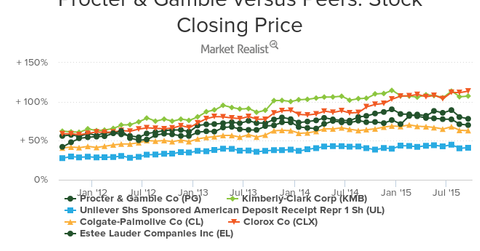P&G’s Strategies for Revamping its Product Portfolio
P&G plans to focus on stronger, consumer meaningful brands—brands with which P&G has the leading market position—and accordingly chooses its portfolio.
Sept. 28 2015, Updated 9:06 a.m. ET

Portfolio reshaping
The Procter & Gamble Company’s (PG) portfolio revamping project has been a major transformational move ever since A.G. Lafley, the company’s Chairman, President, and CEO, was re-appointed in 2013. To learn more about A.G. Lafley’s return to Procter & Gamble, please read Procter & Gamble Benefits from A.G. Lafley’s Return as CEO.
After P&G’s beauty brands merger with Coty (COTY), the company will focus on 10 product categories and about 65 brands.
[marketrealist-chart id=664868]
According to P&G’s CFO Jon Moeller, the company plans to focus on stronger, consumer meaningful brands—brands with which P&G has the leading market position—and accordingly chooses its 10 product categories. As consumer staple (XLP) products have low demand elasticity, P&G is looking to focus on brands whose industries are relatively more attractive and where market positioning is more robust, so that the company can enjoy higher levels of profitability.
After the completion of the merger of its beauty brands with COTY, and after Duracell’s deal with Berkshire Hathaway (BRK-B), P&G will have exited 60% of its current brand portfolio. With these exits, P&G will also exit the complexity these brands create, but the company will still retain 94% of its profit before tax, after the exits.
Focusing on value creation
After the company’s 4Q15 earnings results, P&G CEO A.G. Lafley repeatedly emphasized the company’s focus on “value creation” and “sustainable growth” for its multiple brands and segments. The company believes as the portfolio transformation is completed, profitability will improve and pricing will stabilize.
P&G reported a slight improvement in the core gross margin in 4Q15. The company’s core gross profit margin increased by 1.1% to 48% in 4Q15, compared to 4Q14. The operating margin for 4Q15 was reported at 5.2%, compared to 16.1% in 4Q14. This included the Venezuela charge of 11.4%, which was the main reason behind the decline in operating margin.
Venezuela impact
During the earnings release, P&G announced that the company will stop consolidating the results of its local Venezuelan operations in its GAAP financial statements, effective June 30, 2015. This decision was due to P&G’s inability to convert currency or pay dividends, which led the company to switch to a change in the accounting system. Recently, Clorox (CLX) also discontinued its Clorox Venezuela operations effective September 22, 2014.
P&G has exposure in the SPDR S&P Dividend ETF (SDY), with 1.3% of the total weight of the portfolio as of September 11, 2015.
In the next and final part of this series, we’ll look at the mega brands in P&G’s new portfolio.
